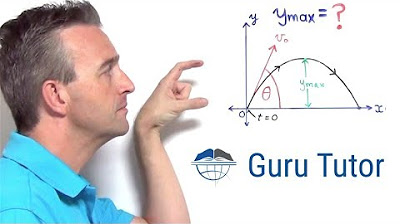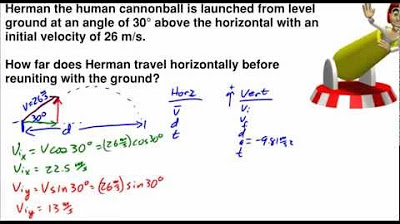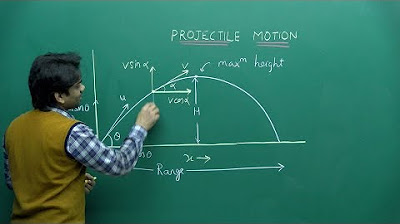Time of Flight in Projectile Motion | Physics
TLDRThis video script delves into the concept of the time of light in projectile motion, explaining it through a detailed analysis of a ball's trajectory. The presenter breaks down the motion into horizontal and vertical components, using the initial velocity and angle of projection to derive the time of flight equation. Two methods are introduced to calculate the time it takes for the ball to reach its maximum height and complete its path. The final example, with an initial velocity of 20 meters per second at a 45-degree angle, results in a time of flight of 2.9 seconds, effectively illustrating the concept.
Takeaways
- 🏀 In projectile motion, an object moves along a curved path due to its initial velocity and the acceleration caused by gravity.
- 📈 The horizontal component of velocity (u_x) is given by u*cos(θ), and the vertical component (u_y) is u*sin(θ), where θ is the angle of projection.
- 🔄 At maximum height, the vertical velocity component becomes zero, indicating a temporary halt in the upward motion before descending.
- ⏳ The time of flight (capital T) is the total duration for the projectile to complete its entire motion from point P to R.
- 🕒 The time 't' represents the time taken for the projectile to complete either the upward or downward motion, which is half of the total time of flight (T = 2t).
- 🎯 To find the time taken to reach maximum height (from P to Q), one can use the equation v = u + at, with v = 0, u = u*sin(θ), and a = -g.
- 📌 The time taken to travel from P to R (time of light) can be calculated using the formula T = 2*(u*sin(θ))/g.
- 🔢 Using the given values (u = 20 m/s, θ = 45°, g = 9.8 m/s²), the time of light for the projectile is calculated to be 2.9 seconds.
- 📊 The second method for deriving the time of flight involves considering the vertical motion and using the displacement equation s = ut + 0.5at², with s = 0 since there's no vertical displacement at the peak.
- 🌟 The key to understanding projectile motion is recognizing that the horizontal and vertical components of motion are independent and follow separate kinematic equations.
- 📚 The concepts of time of flight and time of light are crucial in analyzing the trajectory and duration of a projectile's motion.
Q & A
What is the time of light in projectile motion?
-The time of light in projectile motion refers to the total time taken by the object, such as a ball, to complete its entire trajectory from the point of projection to the point where it returns to its original horizontal level.
What is the initial velocity of the ball in the horizontal direction (u_x) when the ball is kicked with an initial velocity (u) of 20 meters per second at an angle of 45 degrees?
-The initial velocity in the horizontal direction (u_x) is equal to the initial velocity (u), which is 20 meters per second, because it is not affected by the angle of projection. So, u_x = u = 20 m/s.
What is the initial velocity of the ball in the vertical direction (u_y) when the ball is projected at an angle of 45 degrees with an initial velocity of 20 m/s?
-The initial velocity in the vertical direction (u_y) is determined by the initial velocity (u) and the angle of projection (θ). It is calculated as u * sin(θ). For a 45-degree angle, u_y = u * sin(45°) = 20 m/s * sin(45°) = 10√2 m/s.
How does the time of flight (capital t) of a projectile relate to the smaller time (lowercase t) mentioned in the script?
-The time of flight (capital t) is the total time taken by the projectile to complete its entire motion, from the point of projection to the point where it returns to its original horizontal level. It is equal to two times the smaller time (lowercase t), which represents the time taken for the projectile to complete either the upward or the downward motion.
What is the acceleration acting on the ball in the vertical direction during its projectile motion?
-The acceleration acting on the ball in the vertical direction is equal to the acceleration due to gravity (g), which is approximately -9.8 m/s². The negative sign indicates that the direction of this acceleration is downward.
How can we find the time taken by the ball to reach its maximum height?
-To find the time taken by the ball to reach its maximum height, we consider the vertical motion of the ball. We know that the initial velocity (u_y) at the maximum height is 0 m/s, the initial velocity in the vertical direction is u * sin(θ), and the acceleration is -g. Using the equation v = u + a*t, where v is the final velocity, we solve for t when v = 0. This gives us t = u * sin(θ) / g.
What is the equation for the time of flight (capital t) of a projectile derived from the vertical motion?
-The equation for the time of flight (capital t) of a projectile derived from the vertical motion is t = 2 * (u * sin(θ)) / g, where u is the initial velocity, θ is the angle of projection, and g is the acceleration due to gravity.
How long does it take for a ball with an initial velocity of 20 m/s at a 45-degree angle of projection to reach its maximum height?
-Using the derived equation for the time to reach maximum height, t = u * sin(θ) / g, and plugging in the values u = 20 m/s, θ = 45°, and g = 9.8 m/s², we get t = (20 m/s * sin(45°)) / 9.8 m/s², which simplifies to t = (20 * √2 / 2) / 9.8 ≈ 1.43 seconds.
What is the total time of flight for the ball with an initial velocity of 20 m/s at a 45-degree angle of projection?
-Using the equation for the time of flight t = 2 * (u * sin(θ)) / g, and plugging in the values u = 20 m/s, θ = 45°, and g = 9.8 m/s², we find that the total time of flight is t = 2 * (20 * √2 / 2) / 9.8 ≈ 2.9 seconds.
How does the vertical displacement of the ball (sy) affect the equation for the time of flight?
-In the context of the time of flight, the vertical displacement (sy) is considered to be zero because the projectile returns to its original horizontal level at the end of its motion. Thus, the equation for the time of flight does not directly involve sy, but it is derived from the vertical motion equations where sy is initially considered for the calculation of time to reach maximum height.
What is the significance of the angle of projection in determining the time of flight of a projectile?
-The angle of projection plays a crucial role in determining the time of flight of a projectile. The vertical component of the initial velocity (u*sin(θ)) and the horizontal component (u*cos(θ)) are both affected by this angle. The time of flight is directly influenced by the vertical component of the velocity, as it determines how high the projectile will rise before falling back down, thus affecting the total time of flight.
What happens to the horizontal motion of the projectile during its flight?
-The horizontal motion of the projectile is uniform and unaccelerated because there is no acceleration acting in the horizontal direction (assuming air resistance is negligible). The horizontal component of the initial velocity (u*cos(θ)) remains constant throughout the flight, and the projectile continues to move at a constant speed in the horizontal direction.
Outlines
📚 Projectile Motion: Understanding Time of Flight
This paragraph introduces the concept of time of flight in projectile motion, using a ball kicked with an initial velocity of 20 meters per second at a 45-degree angle. It explains the division of the motion into horizontal and vertical components, highlighting that the horizontal component's velocity is given by u*cos(theta) and the vertical component's velocity by u*sin(theta). The time of flight (capital t) is defined as the total time taken for the ball to complete its motion, which is twice the time (smaller t) taken to complete either the upward or downward half of the motion. The paragraph also delves into finding the time taken to reach the maximum height by focusing on the vertical motion and using the equation v = u + at, where v is the final velocity, u is the initial velocity, a is the acceleration due to gravity (negative g), and t is the time. The resulting equation for the time to reach maximum height is t = (u*sin(theta))/g.
🧮 Calculating Time of Flight Using Two Methods
This paragraph presents a detailed explanation of calculating the time of flight for a projectile using two different methods. The first method involves the vertical motion of the ball from point p to r, with the initial velocity (u*sin(theta)), acceleration (negative g), and displacement in the vertical direction (sy) being zero. The equation sy = vi*t + 0.5*a*t^2 is used, where sy is the displacement, vi is the initial velocity, a is the acceleration, and t is the time. By setting sy to zero and solving for t, the equation for time of flight is derived as t = 2*(u*sin(theta))/g. The second method uses the same initial conditions but focuses on the displacement along the x-axis, which remains constant in the vertical direction. The equation is rearranged to solve for time, resulting in the same formula for time of flight. The paragraph then applies this formula to the given example, where the initial velocity is 20 m/s, the projection angle is 45 degrees, and the acceleration due to gravity is 9.8 m/s^2, yielding a time of flight of 2.9 seconds for the ball to move from p to r.
Mindmap
Keywords
💡Projectile Motion
💡Initial Velocity (u)
💡Angle of Projection
💡Horizontal Velocity (u_x)
💡Vertical Velocity (u_y)
💡Time of Flight
💡Acceleration (g)
💡Maximum Height
💡Displacement
💡Equations of Motion
💡Time of Light
Highlights
Projectile motion involves a ball moving along a curved path with an initial velocity of 20 meters per second.
The angle of projection is 45 degrees, which is a key factor in the motion analysis.
The horizontal component of velocity is given by u*cos(theta), and the vertical component by u*sine(theta).
At maximum height, the vertical component of the velocity becomes zero.
The motion of the ball is divided into two parts: upward motion (from p to q) and downward motion (from q to r), each taking time t.
The time of flight (capital t) is the total time taken by the ball to move from p to r, which is twice the time of either the upward or downward motion (smaller t).
The time taken by the ball to reach maximum height is derived by considering only the vertical motion and setting final velocity (v) to zero.
The equation for time taken to reach maximum height is t = (u*sine(theta))/g.
The time of flight (t) is calculated as t = 2*(u*sine(theta))/g, which is the equation of time of light for a projectile.
An alternative method for deriving the time of flight involves considering the vertical motion from p to r with zero displacement in the y-direction.
The displacement equation s = v_i*t + 0.5*a*t^2 is used with initial vertical velocity (u_i = u*sine(theta)) and acceleration (a = -g).
By solving the displacement equation with s = 0, the time of flight equation t = 2*(u*sine(theta))/g is derived again.
The practical application of this concept is demonstrated by calculating the time of flight for a ball thrown with an initial velocity of 20 m/s at a 45-degree angle, taking 2.9 seconds to move from p to r.
Understanding the time of light and projectile motion is crucial for analyzing real-world scenarios such as sports and physics-based problems.
The lecture provides a comprehensive explanation of the concepts, making it accessible for learners to grasp the principles of projectile motion.
The use of mathematical equations and step-by-step derivations in the lecture enhances the understanding of projectile motion and the time of light.
The lecture emphasizes the importance of distinguishing between the total time of flight (capital t) and the time at a particular instant (smaller t).
The concept of dividing the motion into upward and downward parts simplifies the analysis and provides a clear understanding of the time of flight.
The lecture's approach to explaining projectile motion with a real-world example makes the abstract concepts more tangible and relatable.
The inclusion of both methods for deriving the time of flight equation caters to different learning styles and provides a thorough understanding of the topic.
The lecture's structure, starting with a practical scenario and moving towards mathematical derivations, effectively builds a bridge between theoretical and applied physics.
The time of light concept is integral to understanding the full trajectory of a projectile, which has applications in various fields such as engineering and physics.
The lecture's focus on the angle of projection and its impact on the time of flight highlights the significance of initial conditions in projectile motion analysis.
Transcripts
Browse More Related Video

Projectile Launched of a Cliff

Projectile Motion (of an Object Fired at an Angle) - A Level Physics

Projectile Motion Maximum Height Formula Derivation

Regents Physics: Angled Projectile Problem Practice

NEET Physics | Projectile Motion | Theory & Problem-Solving | In English | Misostudy

Projectile Motion: Shooting a Basketball Problem
5.0 / 5 (0 votes)
Thanks for rating: